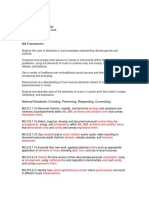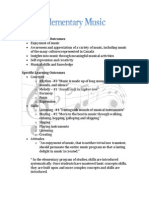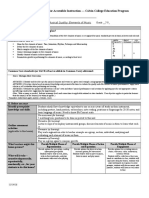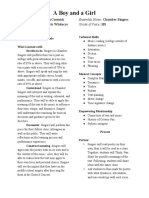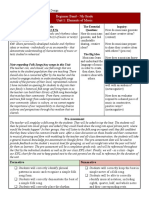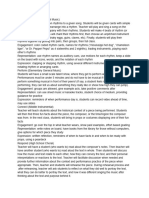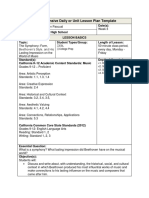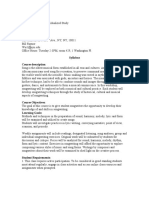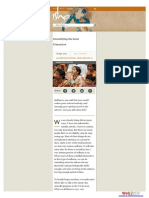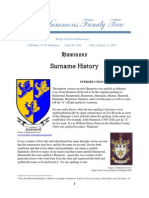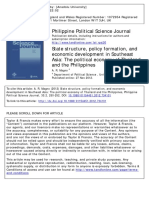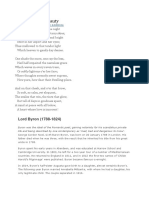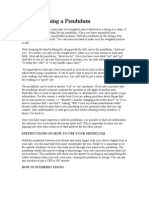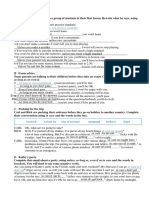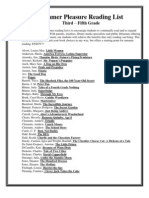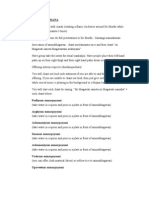2010 04 28 - Conover
2010 04 28 - Conover
Uploaded by
Patricia Portzline ConoverCopyright:
Available Formats
2010 04 28 - Conover
2010 04 28 - Conover
Uploaded by
Patricia Portzline ConoverOriginal Title
Copyright
Available Formats
Share this document
Did you find this document useful?
Is this content inappropriate?
Copyright:
Available Formats
2010 04 28 - Conover
2010 04 28 - Conover
Uploaded by
Patricia Portzline ConoverCopyright:
Available Formats
P Conover
___________________
Grade Level: 6 th
Unit: Rhythm Meter & Conducting Lesson: Welcome to Cycle & Feel the Beat
Focus: (Concept or skills to be emphasized)
Rhythm Melody Theory Expressive Qualities Form Harmony Style Singing Playing Instruments Listening
Standards Achieved:
Singing, alone and with others, a varied repertoire of music. Performing on instruments, alone and with others, a varied repertoire of
music. Improvising melodies, variations and accompaniments. Composing and arranging music within specific guidelines.
Reading and notating music. Listening to, analyzing and describing music.
Evaluating music and music performances. Understanding music in relation to history and culture.
Understanding relationships between music, the other arts and disciplines outside the arts.
Vocabulary (to be emphasized): rhythm, beat, meter, duple and triple, mixed meter, conducting
Objectives: (What students will learn/be able to do)
Discuss the relationship between their personality and musical taste by reviewing their song lists on their IPODS.
Learn and perform “Come and Follow Me”. Determine meter, macro and micro beat, and meter.
Through listening, students will begin to understand how beats are organized and how that determines meter.
Students will learn the basic skills for conducting a duple and triple piece of music.
Students will develop and write a conducting plan, rehearse their conducting patterns and conduct the class.
Activities:
Students will sight read basic rhythmic notation from the board to prep for learning “Come and Follow Me”. Students will complete and present
“What’s On Your Ipod”. Students may bring in a song selection to share with the class. Students will listen to several pieces of music to
determine the meter and then learn the corresponding conducting pattern in preparation for their conducting exam later in cycle. Students will
learn the song and movement to “Come and Follow Me” and practice to prep to perform in a 2, 3, and 4 part round.
Materials and Equipment:
Listening examples, white board, listening selections, IPDODS, rhythm worksheet.
Assessment: teacher observation of student participation/discussion
P Conover
___________________
Grade Level: 7th grade Cycle Unit: All About the Voice
Focus: (Concept or skills to be emphasized)
Rhythm Melody Theory Expressive Qualities Form Harmony Style Singing Playing Instruments Listening
California Standards Achieved:
Singing, alone and with others, a varied repertoire of music. Performing on instruments, alone and with others, a varied repertoire of
music. Improvising melodies, variations and accompaniments. Composing and arranging music within specific guidelines.
Reading and notating music. Listening to, analyzing and describing music.
Evaluating music and music performances. Understanding music in relation to history and culture.
Understanding relationships between music, the other arts and disciplines outside the arts.
Vocabulary (to be emphasized): ethnomusicologist, vocal folds, larynx, vocal style, soprano, alto, tenor, bass, -ations of singing
Objectives: (What students will learn/be able to do)
Play Vocal Jeopardy to review for Thursday’s Voice Unit Quiz.
Activities: The Student(s) will…
1. Begin class with a journal entry response to the following question:
What is an effective use of the voice? (Students are to choose 2 of the 4 prompts)
Materials and Equipment:
Vocal Jeopardy, whiteboard
Assessment: teacher observation of class activity/discussion and complete worksheets
P Conover
___________________
Grade Level: 8 Cycle
th
Unit: Music of the 1960s Lesson: Social Protest Songs
Focus: (Concept or skills to be emphasized)
Rhythm Melody Theory Expressive Qualities Form Harmony Style Singing Playing Instruments Listening
California Standards Achieved:
Singing, alone and with others, a varied repertoire of music. Performing on instruments, alone and with others, a varied repertoire of
music. Improvising melodies, variations and accompaniments. Composing and arranging music within specific guidelines.
Reading and notating music. Listening to, analyzing and describing music.
Evaluating music and music performances. Understanding music in relation to history and culture.
Understanding relationships between music, the other arts and disciplines outside the arts.
Vocabulary (to be emphasized): tone color, rhythm melody, musical elements
Objectives: (What students will learn/be able to do)
1. Students will identify two social protest songs from the 1960s and analyze some of the topical and musical elements.
2. Students will consider the effectiveness of musical elements to convey a message.
Activities: The Student(s) will…
1. Begin class by view the 1960s powerpoint.
2. The teacher will read aloud lyrics to “Blowin in the Wind” and “We Shall Overcome”. Students will discuss the meter of the lyrics,
paying particular attention to the stressed and unstressed words.
3. Students will listen to each of these social protest songs. What musical and topical elements can we speak about in each? (Title,
Subject classification, tone color, rhythm, melody, etc)
4. Students will respond to these elements while listening using the Song Chart sheet.
5. The teacher will ask students what ways these elements can be used to convey subject matter. For example, should an angry-sounding
voice be used in a rap song about the aftermath of a crime? Should a smooth, lyrical melody be used exclusively in love songs? Does
an anti-war song need angry sounds in either tone color or rhythm? Can the message be conveyed as effectively using a different
style?
6. Extension: Music often serves as a catalyst to draw society attention to certain issues. Why does music have this effect? What are
some songs or themes in current music that have been used as a call to action?
Materials and Equipment: Listening examples, Song Chart sheet, whiteboard
Assessment: Class discussion, individual work, teacher observation
You might also like
- Songwriting Unit PlanDocument8 pagesSongwriting Unit Planapi-439457924No ratings yet
- Music With Feelings: Music Lesson Plans for Teachers With or Without Music ExperienceFrom EverandMusic With Feelings: Music Lesson Plans for Teachers With or Without Music ExperienceRating: 3 out of 5 stars3/5 (2)
- Beginning Ukulele Unit CurriculumDocument6 pagesBeginning Ukulele Unit Curriculumapi-337264894No ratings yet
- Communicating Through Music Performance LessonDocument3 pagesCommunicating Through Music Performance Lessonapi-252313121No ratings yet
- Teaching Music IN Elementary Grades: Course ObjectiveDocument15 pagesTeaching Music IN Elementary Grades: Course ObjectiveEddie Mamusog Awit100% (1)
- Dance As Art and Elements of DanceDocument9 pagesDance As Art and Elements of Danceapi-348439396No ratings yet
- Presentation HandoutDocument9 pagesPresentation Handoutapi-238119018No ratings yet
- Curriculum ProjectDocument10 pagesCurriculum Projectapi-218909027No ratings yet
- Lesson 1 Musical Quality Fa16Document7 pagesLesson 1 Musical Quality Fa16api-336520468100% (1)
- Unit Plan OutlineDocument6 pagesUnit Plan Outlineapi-532403608No ratings yet
- Shannon Smith - Leadership Project Ukulele Beginning CurriculumDocument6 pagesShannon Smith - Leadership Project Ukulele Beginning Curriculumapi-441833033No ratings yet
- Final Curriculum Document PearsallDocument30 pagesFinal Curriculum Document Pearsallapi-301509872No ratings yet
- Baroque Lesson PlanDocument2 pagesBaroque Lesson Planapi-334651370No ratings yet
- Lesson3 Musical Quality Fa16Document3 pagesLesson3 Musical Quality Fa16api-336520468No ratings yet
- Social Science Lesson PlanDocument6 pagesSocial Science Lesson Planapi-284815250No ratings yet
- High School Unit PlanDocument19 pagesHigh School Unit Planapi-583268795No ratings yet
- Lesson Plan For Observation 2020-2021Document4 pagesLesson Plan For Observation 2020-2021Joseph GiammonaNo ratings yet
- A Boy and A Girl-Eric Whitacre Rehearsal PlanDocument3 pagesA Boy and A Girl-Eric Whitacre Rehearsal Planapi-314357293No ratings yet
- Syncopated Clock Listening LessonDocument1 pageSyncopated Clock Listening Lessonapi-242480548No ratings yet
- Curriculum Project-2Document5 pagesCurriculum Project-2api-266155292No ratings yet
- Curriculum Project CompleteDocument14 pagesCurriculum Project Completeapi-663722971No ratings yet
- Lesson Plan Teacher Name: Joseph C Kim Grade: Grade 6 General Music Class Title of Lesson: Creating An Own Melody Based On A CharacterDocument1 pageLesson Plan Teacher Name: Joseph C Kim Grade: Grade 6 General Music Class Title of Lesson: Creating An Own Melody Based On A Characterapi-207387376No ratings yet
- Unit Topic and RationaleDocument4 pagesUnit Topic and Rationaleapi-237496570No ratings yet
- C I P o S HandoutDocument4 pagesC I P o S Handoutapi-279660056No ratings yet
- Scope and Sequence: Fourth Grade MusicDocument9 pagesScope and Sequence: Fourth Grade MusicFroilene Nicole TangalinNo ratings yet
- Lesson2 Musical Quality Fa16Document4 pagesLesson2 Musical Quality Fa16api-336520468No ratings yet
- Edtpa Pfa Planning Commentary FinalDocument9 pagesEdtpa Pfa Planning Commentary Finalapi-302458246No ratings yet
- Sample Music Unit Beginner BandDocument5 pagesSample Music Unit Beginner Bandapi-308383811No ratings yet
- Grade 5 Elements of MusicDocument4 pagesGrade 5 Elements of MusicsnowyznNo ratings yet
- Esslinger MCF Lesson PlanDocument5 pagesEsslinger MCF Lesson Planapi-690327413No ratings yet
- Conquest Lesson PlanDocument4 pagesConquest Lesson PlanChristopher VasquezNo ratings yet
- National Standards Lesson PlansDocument2 pagesNational Standards Lesson Plansapi-710133243No ratings yet
- General Music: 1st Grade: Standard 1.0 SingingDocument9 pagesGeneral Music: 1st Grade: Standard 1.0 SingingAmanda-KoonsNo ratings yet
- Grace Templeton Mued 206 Honors OptionDocument26 pagesGrace Templeton Mued 206 Honors Optionapi-499594685No ratings yet
- Fifth Grade Music CurriculumDocument22 pagesFifth Grade Music Curriculumbbbradley100% (1)
- 4 Week Unit Plan Week 3Document4 pages4 Week Unit Plan Week 3api-252936993No ratings yet
- Unit PlanDocument4 pagesUnit Planapi-295674341No ratings yet
- Leadership ProjectDocument6 pagesLeadership Projectapi-330313689No ratings yet
- Music Progression DocumentDocument15 pagesMusic Progression DocumentMichelle KiernanNo ratings yet
- SecondaryunitfinalDocument11 pagesSecondaryunitfinalapi-439220457No ratings yet
- Music Lesson Plan AssignmentDocument5 pagesMusic Lesson Plan Assignmentapi-294620957100% (1)
- Unit PlanDocument4 pagesUnit Planapi-300777609No ratings yet
- Lesson Plan in Music' Tessa - Kent - PermelDocument5 pagesLesson Plan in Music' Tessa - Kent - PermelKent MarianitoNo ratings yet
- Curriculum PresentationDocument13 pagesCurriculum Presentationapi-624478936No ratings yet
- Full Year CurriculumDocument13 pagesFull Year CurriculumJessica BrummelNo ratings yet
- Ubi Caritas CP Rehearsal PlanDocument3 pagesUbi Caritas CP Rehearsal Planapi-247856386No ratings yet
- The Application of Communicative Methods in Teaching English VocabularyDocument8 pagesThe Application of Communicative Methods in Teaching English VocabularyValentina MoshulNo ratings yet
- Musicians: by Taurin RobinsonDocument32 pagesMusicians: by Taurin Robinsonapi-302993454No ratings yet
- Tmu Lesson PlanDocument3 pagesTmu Lesson Planapi-609434428No ratings yet
- Music Ubd TemplateDocument8 pagesMusic Ubd Templateapi-335115362No ratings yet
- Classroom Music Lesson PlanDocument2 pagesClassroom Music Lesson Planapi-300296416No ratings yet
- Ohio Music Standards Final 2Document5 pagesOhio Music Standards Final 2Michael CottenNo ratings yet
- Music Lesson Plan: Grade Level: Unit: Date: LessonDocument1 pageMusic Lesson Plan: Grade Level: Unit: Date: LessonDrew WichmanNo ratings yet
- SongwritingDocument5 pagesSongwritingdiegoblrdNo ratings yet
- Arts Ug1325 PDFDocument5 pagesArts Ug1325 PDFdiegoblrdNo ratings yet
- TEAM Lesson Plan Template: StandardsDocument5 pagesTEAM Lesson Plan Template: Standardsapi-317249345No ratings yet
- General Music: 2nd Grade: Standard 1.0 SingingDocument9 pagesGeneral Music: 2nd Grade: Standard 1.0 SingingAmanda-KoonsNo ratings yet
- Arizona Music Standards: Arizona Department of Education - Adopted June 26, 2006 Page 1 of 56Document56 pagesArizona Music Standards: Arizona Department of Education - Adopted June 26, 2006 Page 1 of 56Jesús CaroNo ratings yet
- Chrisa Kitsiou, Music Theory - Solfège, Developing Aural Skills - Book 1From EverandChrisa Kitsiou, Music Theory - Solfège, Developing Aural Skills - Book 1No ratings yet
- Daum 2008Document326 pagesDaum 2008Vlad PuscasuNo ratings yet
- Intensifying The InnerdimensionDocument8 pagesIntensifying The InnerdimensionAnilNo ratings yet
- Sindarin English DictionaryDocument68 pagesSindarin English Dictionaryamargen1No ratings yet
- Ancient Egyptian Astronomy PDFDocument4 pagesAncient Egyptian Astronomy PDFrobert kerkesNo ratings yet
- FeedbackDocument274 pagesFeedbackDergosNo ratings yet
- NL 2 - Hammons Surname HistoryDocument10 pagesNL 2 - Hammons Surname Historyapi-197921310No ratings yet
- State Structure, Policy Formation, and Economic Development in Southeast Asia: The Political Economy of Thailand and The PhilippinesDocument4 pagesState Structure, Policy Formation, and Economic Development in Southeast Asia: The Political Economy of Thailand and The PhilippinesCharlie MendozaNo ratings yet
- She Walks in BeautyDocument7 pagesShe Walks in Beautykspalmo100% (1)
- Mu6Me-Iia-1: Cabolutan Elementary School Cabolutan, San Agustin Romblon Lesson PlanDocument2 pagesMu6Me-Iia-1: Cabolutan Elementary School Cabolutan, San Agustin Romblon Lesson Planliezl heranaNo ratings yet
- Bitch by BeverlyDocument2 pagesBitch by BeverlyHiiNo ratings yet
- Cinderella OriginalDocument12 pagesCinderella OriginalLuis Fernando Regalado PérezNo ratings yet
- Pendulum and Dowsing Instruction - NotesDocument6 pagesPendulum and Dowsing Instruction - NotesShane Halaska67% (3)
- Hometask Zero&First ConditionalsDocument2 pagesHometask Zero&First ConditionalsАриф «arifjan» ГасановNo ratings yet
- Afsaneh NajmabadiDocument5 pagesAfsaneh NajmabadiTrina Nileena BanerjeeNo ratings yet
- Summer Pleasure Reading ListDocument3 pagesSummer Pleasure Reading ListasraghuNo ratings yet
- Gods of Mikkleheimr (Lore For 5e Homebrew World)Document8 pagesGods of Mikkleheimr (Lore For 5e Homebrew World)Jake ShepherdNo ratings yet
- Christian Origins and The Resurrection of JesusDocument17 pagesChristian Origins and The Resurrection of JesusDustin HayhurstNo ratings yet
- Sigmund FreudDocument13 pagesSigmund FreudMr. MuneerNo ratings yet
- Contemporary Architecture: V Sem TestDocument29 pagesContemporary Architecture: V Sem TestRishi RishendraNo ratings yet
- Sri Murthy ArchanaDocument3 pagesSri Murthy ArchanatransjmkNo ratings yet
- Tulio Lombardo in VeniceDocument20 pagesTulio Lombardo in VeniceIvana JurčevićNo ratings yet
- 4TH Grading Grade 7Document2 pages4TH Grading Grade 7Gemskie DuyaNo ratings yet
- Jackson 3 7 Homework SolutionDocument3 pagesJackson 3 7 Homework SolutionTruequeandoPachusNo ratings yet
- Gurukula Teacher CourseDocument10 pagesGurukula Teacher CoursePedro RamosNo ratings yet
- Holy Ghost Speak Revivals, Inc.: Come Out Devil... Let My People Go!Document1 pageHoly Ghost Speak Revivals, Inc.: Come Out Devil... Let My People Go!Daniel AbrahamNo ratings yet
- Your Future Prediction Oneonone Activities Reading Comprehension Exercise 64541Document2 pagesYour Future Prediction Oneonone Activities Reading Comprehension Exercise 64541Dung Trần100% (4)
- Preventing Air Bubbles in Epoxy ResinDocument4 pagesPreventing Air Bubbles in Epoxy ResinApitNo ratings yet
- Transport of Metals by Hydrothermal FluidsDocument13 pagesTransport of Metals by Hydrothermal FluidsTpomaNo ratings yet
- Masciandaro - SACER PDFDocument176 pagesMasciandaro - SACER PDFJae Koo Zul0% (1)
